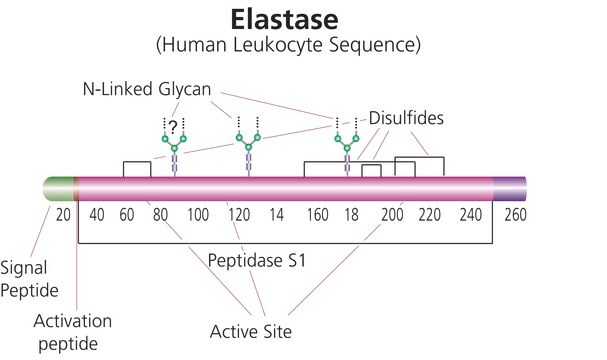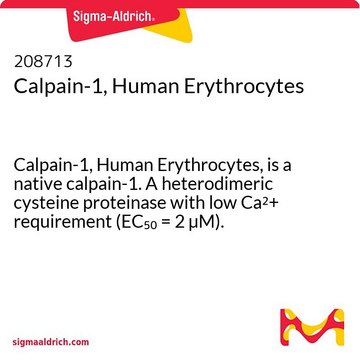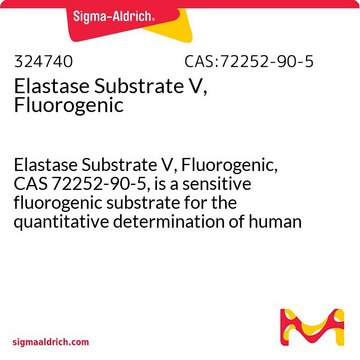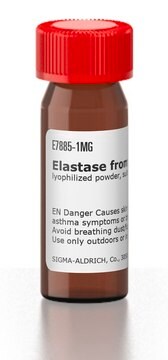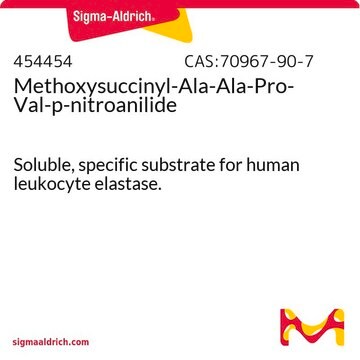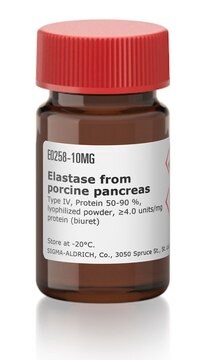324681
Elastase, Human Neutrophil
Elastase, Human Neutrophil, CAS 9004-06-2, is a serine protease that degrades elastin, collagen, and proteoglycans
Sinónimos:
Elastase, Human Neutrophil
Iniciar sesiónpara Ver la Fijación de precios por contrato y de la organización
About This Item
Número de CAS:
Número MDL:
Código UNSPSC:
12352204
NACRES:
NA.77
Productos recomendados
Nivel de calidad
formulario
lyophilized solid
actividad específica
≥20 units/mg protein
fabricante / nombre comercial
Calbiochem®
condiciones de almacenamiento
OK to freeze
Condiciones de envío
ambient
temp. de almacenamiento
−20°C
Descripción general
Elastase, Human Neutrophil, CAS 9004-06-2, is a serine protease that degrades elastin, collagen, and proteoglycans
Native elastase from human neutrophil. A serine protease that degrades elastin, collagen, and proteoglycans. Its overexpression has been implicated in the development of pulmonary emphysema, rheumatoid arthritis, and cystic fibrosis.
Native elastase from human neutrophil. Degrades collagen, elastin, and proteoglycans. Elastase has been implicated in the development of pulmonary emphysema and rheumatoid arthritis.
Advertencia
Toxicity: Standard Handling (A)
Definición de unidad
One unit is defined as the amount of enzyme that will hydrolyze 1.0 µmol of MeO-Suc-Ala-Ala-Pro-Val-pNA (Cat. No. 454454) per min at 25°C, pH 8.0.
Forma física
Salt-free.
Nota de preparación
Prepared from blood that has been shown by certified tests to be negative for HBsAg and for antibodies to HIV and HCV.
Reconstitución
Following reconstitution, aliquot and freeze (-20°C) for long term storage or refrigerate (4°C) for short-term storage. Acidic stock solutions are stable for up to 1 month at 4°C or for up to 1 year at -20°C.
Reconstitute in 50 mM sodium acetate, pH 5.5, with 200 mM NaCl or in other aqueous buffers. Material is most active near a neutral pH, but to maintain stability upon reconstitution, use in a slightly acidic buffer (pH 5.5) to avoid autolysis.
Nota de análisis
Major band by SDS-PAGE
Otras notas
Siedle, B., et al. 2002. Biorg. Med. Chem.10, 2855.
Junger, W.G., et al. 1992. Biol. Chem. Hoppe-Seyler 373, 691.
Selak, M.A. 1992. Thromb. Haemost.68, 570.
Baugh, R.J., and Travis, J. 1976. Biochemistry15, 836.
Junger, W.G., et al. 1992. Biol. Chem. Hoppe-Seyler 373, 691.
Selak, M.A. 1992. Thromb. Haemost.68, 570.
Baugh, R.J., and Travis, J. 1976. Biochemistry15, 836.
Información legal
CALBIOCHEM is a registered trademark of Merck KGaA, Darmstadt, Germany
Palabra de señalización
Danger
Frases de peligro
Consejos de prudencia
Clasificaciones de peligro
Eye Irrit. 2 - Resp. Sens. 1 - Skin Irrit. 2 - STOT SE 3
Órganos de actuación
Respiratory system
Código de clase de almacenamiento
11 - Combustible Solids
Clase de riesgo para el agua (WGK)
WGK 3
Punto de inflamabilidad (°F)
Not applicable
Punto de inflamabilidad (°C)
Not applicable
Certificados de análisis (COA)
Busque Certificados de análisis (COA) introduciendo el número de lote del producto. Los números de lote se encuentran en la etiqueta del producto después de las palabras «Lot» o «Batch»
¿Ya tiene este producto?
Encuentre la documentación para los productos que ha comprado recientemente en la Biblioteca de documentos.
Los clientes también vieron
Nuestro equipo de científicos tiene experiencia en todas las áreas de investigación: Ciencias de la vida, Ciencia de los materiales, Síntesis química, Cromatografía, Analítica y muchas otras.
Póngase en contacto con el Servicio técnico